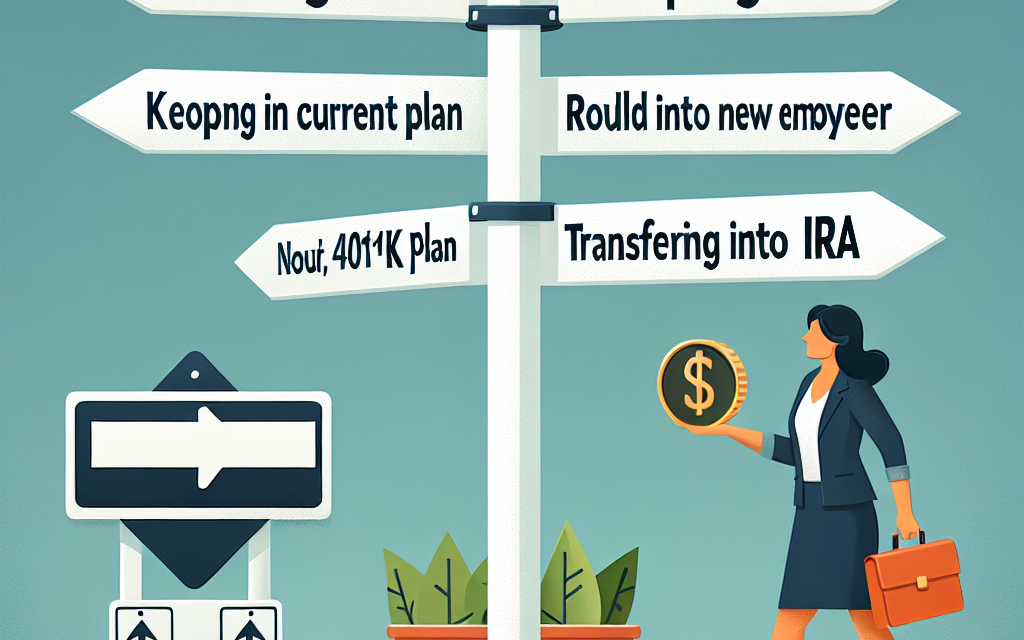“Unlock Your Future: Navigate Your 401(k) Options After Job Transition.”
Introduction
When transitioning from one job to another, it’s essential to consider the future of your 401(k) retirement savings. Exploring your best 401(k) options after leaving your job can significantly impact your financial security in retirement. This process involves understanding the various choices available, such as rolling over your 401(k) into an Individual Retirement Account (IRA), transferring it to your new employer’s plan, or cashing it out. Each option has its own set of advantages and potential drawbacks, making it crucial to evaluate your financial goals, tax implications, and investment strategies. By taking the time to explore these options, you can make informed decisions that align with your long-term retirement objectives.
Understanding 401(k) Rollovers
When you leave a job, one of the critical financial considerations you face is what to do with your 401(k) retirement savings. Understanding 401(k) rollovers is essential for making informed decisions that can significantly impact your financial future. A 401(k) rollover refers to the process of transferring your retirement savings from your former employer’s 401(k) plan to another qualified retirement account, such as an Individual Retirement Account (IRA) or a new employer’s 401(k) plan. This process is crucial because it allows you to maintain the tax-advantaged status of your retirement savings while providing you with more control over your investments.
One of the primary reasons individuals choose to roll over their 401(k) is to consolidate their retirement accounts. When you have multiple retirement accounts from different employers, managing them can become cumbersome. By rolling over your 401(k) into an IRA or a new employer’s plan, you simplify your financial life, making it easier to track your investments and plan for retirement. Additionally, consolidating accounts can help you avoid the risk of losing track of old accounts, which can happen if you change jobs frequently.
Moreover, rolling over your 401(k) can provide you with a broader range of investment options. Many employer-sponsored 401(k) plans have limited investment choices, often restricted to a selection of mutual funds. In contrast, an IRA typically offers a wider array of investment opportunities, including stocks, bonds, ETFs, and even alternative investments. This increased flexibility allows you to tailor your investment strategy to better align with your risk tolerance and financial goals.
It is also important to consider the tax implications of a 401(k) rollover. When executed correctly, a rollover can be done without incurring taxes or penalties. This is typically achieved through a direct rollover, where the funds are transferred directly from your old 401(k) plan to your new IRA or 401(k) plan. Conversely, if you choose to withdraw the funds and then deposit them into another account, you may face tax liabilities and potential penalties if the transfer is not completed within 60 days. Therefore, understanding the mechanics of rollovers is vital to avoid unnecessary tax burdens.
In addition to tax considerations, you should also evaluate the fees associated with your current 401(k) plan versus those of the new account you are considering. Some 401(k) plans charge high administrative fees, which can erode your investment returns over time. By comparing the fee structures of your options, you can make a more informed decision that maximizes your retirement savings.
Furthermore, it is essential to assess the benefits of your current 401(k) plan before deciding to roll over. Some plans offer unique features, such as loan provisions or access to institutional investment options, which may not be available in an IRA. Therefore, weighing the pros and cons of your existing plan against the potential benefits of a rollover is crucial.
In conclusion, understanding 401(k) rollovers is a vital step in managing your retirement savings after leaving a job. By considering factors such as consolidation, investment options, tax implications, fees, and the benefits of your current plan, you can make a well-informed decision that aligns with your long-term financial goals. Taking the time to explore your options will ultimately empower you to secure a more stable and prosperous retirement.
Comparing 401(k) vs. IRA Options
When considering your financial future after leaving a job, one of the most critical decisions involves what to do with your 401(k) plan. This decision often leads to a comparison between keeping your 401(k) with your former employer and rolling it over into an Individual Retirement Account (IRA). Each option has its advantages and disadvantages, and understanding these can help you make an informed choice that aligns with your long-term financial goals.
To begin with, maintaining your 401(k) with your previous employer can provide certain benefits. For instance, if your former employer offers a robust investment lineup, you may find that the available options suit your investment strategy well. Additionally, 401(k) plans often have lower fees compared to IRAs, particularly if your employer has negotiated favorable terms with fund providers. Furthermore, if you are over the age of 55 and leave your job, you may be able to access your 401(k) funds without incurring the typical 10% early withdrawal penalty, which can be a significant advantage in certain financial situations.
On the other hand, rolling over your 401(k) into an IRA can offer greater flexibility and control over your investments. IRAs typically provide a wider range of investment options, including stocks, bonds, mutual funds, and exchange-traded funds (ETFs). This expanded selection allows you to tailor your portfolio more closely to your risk tolerance and investment objectives. Moreover, IRAs often come with more favorable withdrawal options, allowing for penalty-free withdrawals under certain circumstances, such as for first-time home purchases or qualified education expenses.
Another important consideration is the tax implications associated with each option. Both 401(k) plans and IRAs allow for tax-deferred growth, meaning you won’t pay taxes on your investment gains until you withdraw the funds. However, if you choose to roll over your 401(k) into a traditional IRA, you can maintain this tax-deferred status. Conversely, if you opt for a Roth IRA, you will pay taxes on the amount you convert, but your withdrawals in retirement will be tax-free, provided certain conditions are met. This can be particularly advantageous if you anticipate being in a higher tax bracket during retirement.
Additionally, it is essential to consider the fees associated with each option. While 401(k) plans may have lower administrative fees, IRAs can sometimes have higher management fees, especially if you choose to work with a financial advisor. Therefore, it is crucial to evaluate the fee structures of both options to ensure that you are not eroding your investment returns over time.
Ultimately, the decision between keeping your 401(k) or rolling it over into an IRA depends on your individual financial situation, investment preferences, and retirement goals. It is advisable to conduct thorough research and possibly consult with a financial advisor to weigh the pros and cons of each option. By doing so, you can make a choice that not only preserves your hard-earned savings but also positions you for a secure financial future. As you navigate this important decision, remember that the right choice will depend on your unique circumstances and long-term aspirations.
Tax Implications of Cashing Out Your 401(k)
When considering the options available for your 401(k) after leaving a job, one of the most significant factors to evaluate is the tax implications of cashing out your retirement savings. While the prospect of accessing these funds may seem appealing, it is crucial to understand the financial consequences that accompany such a decision. Cashing out your 401(k) can lead to immediate tax liabilities and potential penalties, which can substantially diminish the amount you ultimately receive.
To begin with, it is essential to recognize that the Internal Revenue Service (IRS) treats distributions from a 401(k) as taxable income. This means that if you choose to cash out your account, the amount you withdraw will be added to your taxable income for the year. Consequently, this could potentially push you into a higher tax bracket, resulting in a larger tax bill than you might anticipate. For instance, if you are in a lower tax bracket and cash out a significant sum, the additional income could elevate your overall tax rate, leading to a more substantial tax obligation.
Moreover, if you are under the age of 59½ at the time of withdrawal, the IRS imposes an additional 10% early withdrawal penalty on top of the regular income tax. This penalty is designed to discourage individuals from tapping into their retirement savings prematurely. Therefore, if you cash out your 401(k) before reaching this age threshold, you could face a considerable financial setback, as both the income tax and the penalty will be deducted from your distribution. This dual taxation can significantly reduce the net amount you receive, making it a less favorable option for many individuals.
In addition to the immediate tax implications, it is also important to consider the long-term impact of cashing out your 401(k). By withdrawing your funds, you forfeit the opportunity for those assets to continue growing tax-deferred. The power of compound interest can be a significant advantage in building retirement savings over time. When you cash out, not only do you lose the potential for future growth, but you also miss out on the benefits of tax-deferred compounding, which can substantially affect your financial security in retirement.
Given these considerations, many financial advisors recommend exploring alternative options before deciding to cash out your 401(k). One viable alternative is to roll over your 401(k) into an Individual Retirement Account (IRA) or a new employer’s 401(k) plan, if available. This approach allows you to maintain the tax-deferred status of your retirement savings while providing you with more control over your investment choices. Additionally, rolling over your funds can help you avoid immediate tax liabilities and penalties, preserving your savings for future use.
In conclusion, while cashing out your 401(k) may seem like a quick solution to immediate financial needs, the tax implications and potential penalties can significantly diminish the value of your retirement savings. By understanding the consequences of such a decision and considering alternative options, you can make a more informed choice that aligns with your long-term financial goals. Ultimately, preserving your retirement savings and allowing them to grow can provide you with greater financial security in the years to come.
How to Keep Your 401(k) with Your Former Employer
When you leave a job, one of the important financial considerations is what to do with your 401(k) retirement plan. Many individuals may not realize that one option available to them is to keep their 401(k) with their former employer. This choice can be beneficial for various reasons, and understanding the implications is crucial for making an informed decision.
First and foremost, retaining your 401(k) with your previous employer allows you to maintain the investment options and benefits that were available to you while you were employed. Often, employer-sponsored plans offer a range of investment choices, including mutual funds, stocks, and bonds, which may not be as readily available in an individual retirement account (IRA). By keeping your 401(k), you can continue to benefit from these investment opportunities, potentially allowing your savings to grow in a familiar environment.
Moreover, many employers provide access to professional management and advice regarding your 401(k) investments. This can be particularly advantageous for individuals who may not have the time or expertise to manage their investments independently. By keeping your 401(k) with your former employer, you can continue to leverage these resources, ensuring that your retirement savings are being managed effectively.
In addition to investment options, another significant advantage of maintaining your 401(k) with your former employer is the protection it offers against creditors. Generally, 401(k) plans are protected from creditors under federal law, which means that in the event of bankruptcy or legal judgments, your retirement savings are safeguarded. This level of protection may not be as robust if you choose to roll over your 401(k) into an IRA, where state laws can vary significantly regarding creditor protection.
However, it is essential to consider the potential drawbacks of keeping your 401(k) with your former employer. One of the primary concerns is the lack of control over your account. If you leave your job, you may no longer have access to the same level of information or support regarding your 401(k) as you did while employed. This can make it challenging to monitor your investments and make timely adjustments based on market conditions or personal financial needs.
Additionally, some employers may impose restrictions on how you can manage your 401(k) after leaving the company. For instance, you may not be able to make additional contributions or may face limitations on withdrawals. Therefore, it is crucial to review the specific terms and conditions of your former employer’s plan to understand any restrictions that may apply.
Ultimately, the decision to keep your 401(k) with your former employer should be based on a careful evaluation of your financial situation, investment preferences, and long-term retirement goals. If you value the investment options and professional management available through your former employer’s plan, it may be a wise choice to retain your 401(k). Conversely, if you prefer greater control over your retirement savings or wish to consolidate your accounts for easier management, rolling over your 401(k) into an IRA or a new employer’s plan may be more suitable.
In conclusion, keeping your 401(k) with your former employer is a viable option that offers several benefits, including access to investment choices, professional management, and creditor protection. However, it is essential to weigh these advantages against potential limitations and restrictions. By carefully considering your options, you can make a decision that aligns with your financial goals and sets you on a path toward a secure retirement.
Strategies for Managing Your 401(k) After Job Change
When you leave a job, one of the critical financial decisions you face is what to do with your 401(k) plan. This decision is not merely a matter of convenience; it can significantly impact your long-term financial health. Therefore, understanding the various strategies for managing your 401(k) after a job change is essential for securing your retirement future.
One of the most common options available to you is to leave your 401(k) with your former employer. This choice can be appealing, especially if your previous employer offers a solid investment lineup and low fees. However, it is crucial to consider the implications of this decision. While your funds will remain tax-deferred, you may lose the ability to make additional contributions, and you might face limited access to your account. Additionally, if your former employer undergoes changes, such as a merger or acquisition, your plan could be affected, potentially complicating your financial situation.
Alternatively, you may choose to roll over your 401(k) into an Individual Retirement Account (IRA). This strategy offers several advantages, including a broader range of investment options and potentially lower fees. By rolling over your funds into an IRA, you maintain the tax-deferred status of your retirement savings while gaining greater control over your investment choices. Furthermore, IRAs often provide more flexibility in terms of withdrawals and contributions, which can be beneficial as you navigate your financial landscape post-employment. However, it is essential to be aware of the rules governing rollovers to avoid any tax penalties.
Another viable option is to roll over your 401(k) into your new employer’s retirement plan, if available. This choice can simplify your financial management by consolidating your retirement accounts into one. By doing so, you can continue to benefit from employer matching contributions, which can significantly enhance your retirement savings. However, it is important to review the new plan’s investment options and fees to ensure that it aligns with your financial goals. Additionally, some employers may impose waiting periods before you can access your new plan, which could affect your immediate financial needs.
In some cases, you might consider cashing out your 401(k). While this option may provide immediate access to funds, it is generally not advisable due to the tax implications and potential penalties. Cashing out your retirement savings can lead to a significant tax burden, as the amount withdrawn is typically subject to income tax. Moreover, if you are under the age of 59½, you may incur an additional 10% early withdrawal penalty. Therefore, while the allure of immediate cash may be tempting, it is crucial to weigh the long-term consequences on your retirement savings.
Ultimately, the best strategy for managing your 401(k) after leaving a job depends on your individual circumstances, including your financial goals, investment preferences, and future employment plans. It is advisable to consult with a financial advisor who can provide personalized guidance tailored to your situation. By carefully considering your options and making informed decisions, you can effectively manage your 401(k) and set a solid foundation for your retirement. In conclusion, whether you choose to leave your funds in your former employer’s plan, roll them over into an IRA, transfer them to a new employer’s plan, or cash out, each option carries its own set of advantages and disadvantages that warrant thorough consideration.
The Benefits of Consolidating Retirement Accounts
When an individual leaves a job, one of the critical financial decisions they face is what to do with their 401(k) retirement account. While there are several options available, consolidating retirement accounts often emerges as a beneficial strategy. This approach not only simplifies financial management but also enhances the potential for growth and reduces fees, making it an attractive choice for many.
To begin with, consolidating retirement accounts can significantly streamline an individual’s financial portfolio. When a person has multiple retirement accounts from various employers, keeping track of each one can become cumbersome. By consolidating these accounts into a single 401(k) or an Individual Retirement Account (IRA), individuals can more easily monitor their investments, assess their performance, and make informed decisions regarding their retirement savings. This simplification can lead to better financial oversight and a clearer understanding of one’s overall retirement strategy.
Moreover, consolidating accounts can lead to cost savings. Many retirement accounts come with associated fees, which can vary significantly from one plan to another. By merging accounts, individuals may be able to reduce the total fees they pay, as larger accounts often benefit from lower expense ratios. This reduction in fees can have a substantial impact over time, as even small differences in fees can compound significantly, ultimately affecting the total amount available at retirement. Therefore, by consolidating accounts, individuals not only simplify their financial management but also potentially increase their retirement savings.
In addition to cost savings, consolidating retirement accounts can enhance investment options. Many employer-sponsored 401(k) plans offer a limited selection of investment choices, which may not align with an individual’s risk tolerance or investment strategy. By rolling over a 401(k) into an IRA, individuals typically gain access to a broader range of investment options, including stocks, bonds, mutual funds, and exchange-traded funds (ETFs). This expanded selection allows for greater diversification, which is a crucial component of a robust investment strategy. Diversification can help mitigate risk and improve the potential for returns, ultimately contributing to a more secure retirement.
Furthermore, consolidating retirement accounts can simplify the withdrawal process during retirement. When individuals have multiple accounts, managing withdrawals can become complex and confusing. By consolidating accounts, retirees can streamline their withdrawal strategy, ensuring that they are drawing from their retirement savings in a tax-efficient manner. This simplification can help individuals avoid unnecessary tax liabilities and penalties, allowing them to maximize their retirement income.
It is also worth noting that consolidating retirement accounts can provide a sense of control and empowerment over one’s financial future. By taking proactive steps to manage retirement savings, individuals can feel more confident in their financial decisions. This sense of control can lead to increased engagement with one’s financial planning, encouraging individuals to stay informed about their investments and make adjustments as needed.
In conclusion, the benefits of consolidating retirement accounts after leaving a job are manifold. From simplifying financial management and reducing fees to enhancing investment options and streamlining withdrawals, this strategy can significantly improve an individual’s retirement outlook. As such, it is essential for those transitioning between jobs to carefully consider their options and take advantage of the opportunities that consolidation presents. By doing so, they can pave the way for a more secure and prosperous retirement.
Common Mistakes to Avoid with Your 401(k) After Leaving a Job
When transitioning from one job to another, many individuals face the critical decision of what to do with their 401(k) retirement savings. This decision is not merely a matter of convenience; it can significantly impact one’s financial future. Therefore, it is essential to be aware of common mistakes that can arise during this process, as avoiding them can lead to better long-term outcomes.
One prevalent mistake is failing to understand the implications of leaving a 401(k) with a former employer. While it may seem convenient to leave the account as is, this choice can lead to complications down the line. For instance, if the account balance falls below a certain threshold, the employer may cash out the account without your consent, resulting in unexpected tax liabilities and penalties. Additionally, maintaining a 401(k) with a former employer can lead to a lack of oversight and management, as individuals may forget about the account altogether, potentially missing out on growth opportunities.
Another common error is neglecting to explore the various options available for managing a 401(k) after leaving a job. Many individuals are unaware that they have several choices, including rolling over the funds into an Individual Retirement Account (IRA) or a new employer’s 401(k) plan. Each option has its advantages and disadvantages, and failing to consider these can lead to suboptimal financial decisions. For example, rolling over to an IRA may provide a broader range of investment options and potentially lower fees, while transferring to a new employer’s plan may offer the benefit of consolidating retirement savings.
Moreover, individuals often overlook the importance of understanding the fees associated with their 401(k) options. Whether keeping the funds with a former employer, rolling over to an IRA, or transferring to a new plan, it is crucial to evaluate the fee structures involved. High fees can erode investment returns over time, significantly impacting the overall growth of retirement savings. Therefore, conducting thorough research and comparing the fee structures of different options can help individuals make informed decisions that align with their financial goals.
In addition to overlooking fees, many individuals fail to consider the tax implications of their choices. For instance, cashing out a 401(k) may seem tempting, especially if immediate cash is needed. However, this decision can lead to substantial tax penalties and a significant reduction in retirement savings. Understanding the tax consequences of each option is vital to avoid unnecessary financial burdens and ensure that retirement funds continue to grow.
Lastly, a common mistake is not seeking professional advice when needed. The complexities surrounding retirement accounts can be overwhelming, and individuals may benefit from consulting with a financial advisor. A professional can provide personalized guidance tailored to one’s unique financial situation, helping to navigate the intricacies of 401(k) management after leaving a job. This support can be invaluable in making informed decisions that align with long-term financial objectives.
In conclusion, navigating the options for a 401(k) after leaving a job requires careful consideration and awareness of potential pitfalls. By avoiding common mistakes such as neglecting to understand account implications, overlooking fees, failing to consider tax consequences, and not seeking professional advice, individuals can make informed decisions that enhance their financial future. Taking the time to evaluate these factors can lead to a more secure and prosperous retirement.
Q&A
1. **What are my options for my 401(k) after leaving my job?**
You can leave the money in your former employer’s plan, roll it over to a new employer’s plan, roll it over to an Individual Retirement Account (IRA), or cash it out.
2. **What are the tax implications of cashing out my 401(k)?**
Cashing out your 401(k) may result in income tax on the distribution and a 10% early withdrawal penalty if you are under age 59½.
3. **What is a direct rollover?**
A direct rollover is when your 401(k) funds are transferred directly from your old employer’s plan to your new employer’s plan or to an IRA, avoiding taxes and penalties.
4. **Can I roll my 401(k) into a Roth IRA?**
Yes, you can roll your 401(k) into a Roth IRA, but you will have to pay taxes on the amount rolled over since Roth IRAs are funded with after-tax dollars.
5. **What should I consider when choosing between a new employer’s 401(k) and an IRA?**
Consider factors such as investment options, fees, employer matching contributions, and withdrawal rules.
6. **Are there any deadlines for rolling over my 401(k)?**
Generally, you should complete a rollover within 60 days of receiving the distribution to avoid taxes and penalties.
7. **What happens if I do nothing with my 401(k) after leaving my job?**
If you do nothing, your funds will remain in your former employer’s plan, but you may face limited access and potential fees, and you may not be able to contribute further.
Conclusion
In conclusion, exploring your best 401(k) options after leaving your job is crucial for securing your financial future. Whether you choose to roll over your 401(k) into an IRA, transfer it to a new employer’s plan, or cash it out, each option has its own benefits and potential drawbacks. It’s important to consider factors such as fees, investment choices, and tax implications to make an informed decision that aligns with your long-term financial goals. Taking the time to evaluate these options can help you maximize your retirement savings and ensure a more stable financial future.





